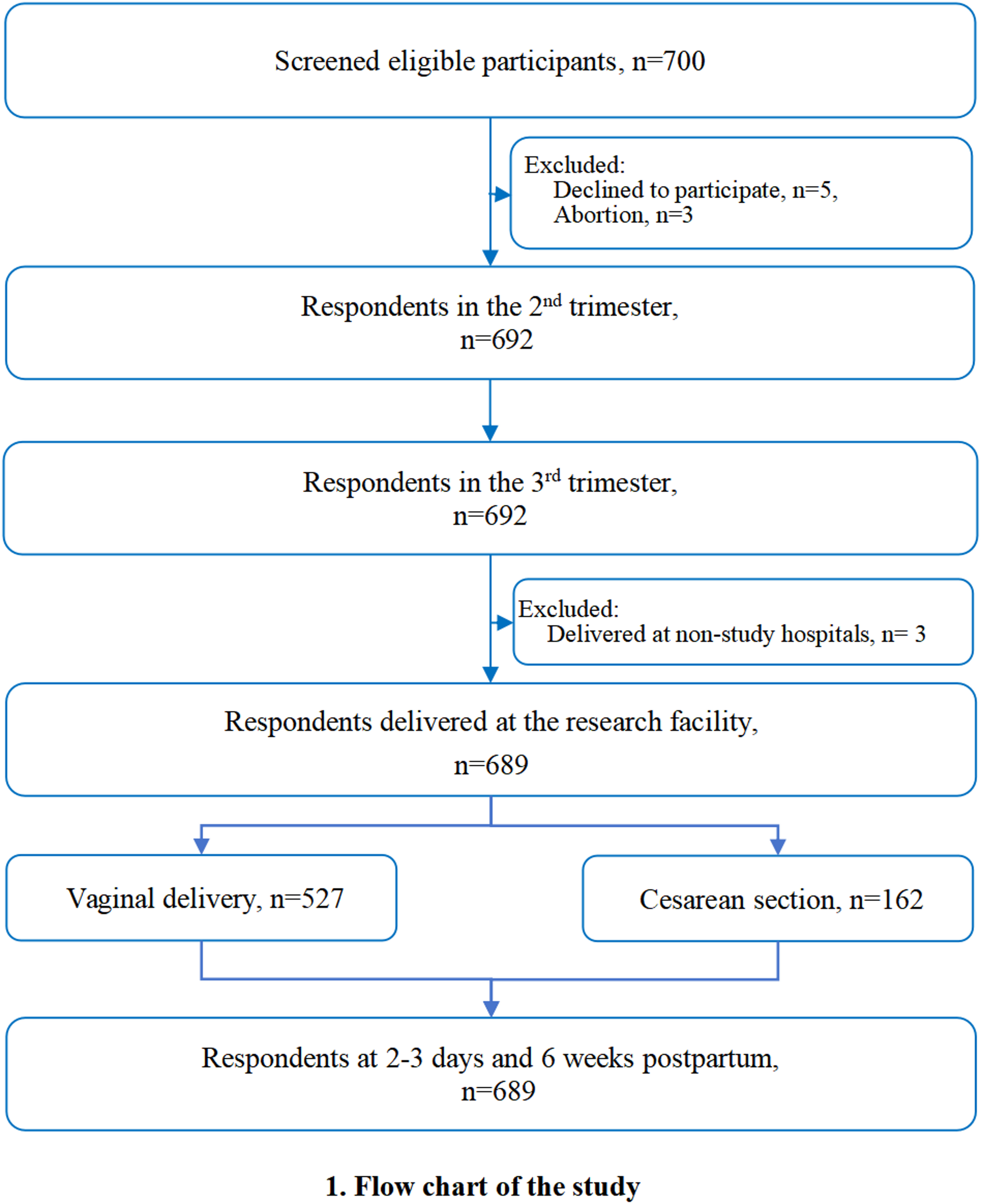Haylen BT, de Ridder D, Freeman RM, Swift SE, Berghmans B, Lee J, et al. An international urogynecological association (IUGA)/international continence society (ICS) joint report on the terminology for female pelvic floor dysfunction. Neurourol Urodyn. 2010;29(1):4–20.
Google Scholar
Chuang YC, Liu SP, Lee KS, Liao L, Wang J, Yoo TK, et al. Prevalence of overactive bladder in China, Taiwan and South Korea: results from a cross-sectional, population-based study. Low Urin Tract Symptoms. 2019;11(1):48–55.
Google Scholar
Santander J, Plata M, Zuluaga L, Azuero J, Daza F, Trujillo CG, et al. What is the real burden of the overactive bladder? Results from a national prevalence study. Neurourol Urodyn. 2022;41(4):926–34.
Google Scholar
Chen HJ, Hsiao SM, Yang CF, Lee CN, Wang YW, Guo DW, et al. Overactive bladder during pregnancy: a prospective longitudinal study. Medicina (Kaunas). 2022;58(2): 243.
Google Scholar
Blomquist JL, Muñoz A, Carroll M, Handa VL. Association of delivery mode with pelvic floor disorders after childbirth. JAMA. 2018;320(23):2438–47.
Google Scholar
Peyronnet B, Mironska E, Chapple C, Cardozo L, Oelke M, Dmochowski R, et al. A comprehensive review of overactive bladder pathophysiology: on the way to tailored treatment. Eur Urol. 2019;75(6):988–1000.
Google Scholar
Poole OV, Uchiyama T, Skorupinska I, Skorupinska M, Germain L, Kozyra D, et al. Urogenital symptoms in mitochondrial disease: overlooked and undertreated. Eur J Neurol. 2019;26(8):1111–20.
Google Scholar
Kenne KA, Wendt L, Brooks Jackson J. Prevalence of pelvic floor disorders in adult women being seen in a primary care setting and associated risk factors. Sci Rep. 2022;12(1): 9878.
Google Scholar
Hendrickson WK, Allshouse AA, Nygaard IE, Swenson CW. Overactive bladder in late pregnancy to 1 year after first vaginal delivery. Urogynecology. 2024;30(4):433–42.
Google Scholar
Iglesia CB. Pelvic floor changes: consequences of pregnancy and delivery. BJOG. 2016;123(5):830.
Google Scholar
Burnett LA, Boscolo FS, Laurent LC, Wong M, Alperin M. Uncovering changes in proteomic signature of rat pelvic floor muscles in pregnancy. Am J Obstet Gynecol. 2019;221(2):130.e1-130.e9.
Google Scholar
Zhen Y, Yang F. Study on relationship between interaction of estrogen, progesterone and relaxin with stress urinary incontinence during pregnancy. Chongqing Med Sci. 2018;47(14):1885–8.
Kamisan Atan I, Zhang W, Shek KL, Dietz HP. Does pregnancy affect pelvic floor functional anatomy? A retrospective study. Eur J Obstet Gynecol Reprod Biol. 2021;259:26–31.
Google Scholar
Lang JH, Zhu L. Female pelvic floor (2nd edition). Beijing: People’s Medical Publishing House;2018.
Lee WL, Chang CP, Wang PH. Overactive bladder syndrome in nulliparous women. J Chin Med Assoc. 2021;84(9):809–10.
Google Scholar
Reynolds WS, Fowke J, Dmochowski R. The burden of overactive bladder on US public health. Curr Bladder Dysfunct Rep. 2016;11(1):8–13.
Google Scholar
Branch of Women’s Health Care, Chinese Preventive Medicine Association. Guideline to postpartum health services. Chin J Woman Child Health Res. 2021;6(32):767–781.
Machin D, Campbell M, Fayers P, Pinol A. Sample size tables for clinical studies, 2nd Edition [M/OL]. Blackwell Science. Malden, Mass. 1997.
Jiang H, Mei Y, Wang X, Zhao Z, Lin B, Wang W, et al. Professional calling among nursing students: a latent profile analysis. BMC Nurs. 2023;22(1): 299.
Google Scholar
Åhlund S, Rothstein E, Rådestad I, Zwedberg S, Lindgren H. Urinary incontinence after uncomplicated spontaneous vaginal birth in primiparous women during the first year after birth. Int Urogynecol J. 2020;31(7):1409–16.
Google Scholar
Tähtinen RM, Cartwright R, Tsui JF, Aaltonen RL, Aoki Y, Cárdenas JL, et al. Long-term impact of mode of delivery on stress urinary incontinence and urgency urinary incontinence: a systematic review and meta-analysis. Eur Urol. 2016;70(1):148–58.
Google Scholar
Thorp JM Jr., Norton PA, Wall LL, Kuller JA, Eucker B, Wells E. Urinary incontinence in pregnancy and the puerperium: a prospective study. Am J Obstet Gynecol. 1999;181(2):266–73.
Google Scholar
Hyakutake MT, Han V, Baerg L, Koenig NA, Cundiff GW, Lee T, et al. Pregnancy-associated pelvic floor health knowledge and reduction of symptoms: the PREPARED randomized controlled trial. J Obstet Gynaecol Can. 2018;40(4):418–25.
Google Scholar
Wu HY, Qian L, Li NN. Analysis of pelvic floor function status and influencing factors in parturient women. Prev Med. 2019;31(6):625–7.
Berzuk K, Shay B. Effect of increasing awareness of pelvic floor muscle function on pelvic floor dysfunction: a randomized controlled trial. Int Urogynecol J. 2015;26(6):837–44.
Google Scholar
Wang JL, Ma JQ, Xu MY, Li F, Ren F, Guo YF, et al. Comparison of the effects of different growth standards on infants in urban Shanghai: a cluster-randomized controlled trial. Chin Med J (Engl). 2019;132(1):4–10.
Google Scholar
Liu P, Xu L, Wang Y, Zhang Y, Du Y, Sun Y, et al. Association between perinatal outcomes and maternal pre-pregnancy body mass index. Obes Rev. 2016;17:1091–102.
Google Scholar
Woodley SJ, Lawrenson P, Boyle R, Cody JD, Mørkved S, Kernohan A, et al. Pelvic floor muscle training for preventing and treating urinary and faecal incontinence in antenatal and postnatal women. Cochrane Database Syst Rev. 2020,5(5):CD007471.
Rieger MM, Wong M, Burnett LA, Sesillo FB, Baynes BB, Alperin M. Mechanisms governing protective pregnancy-induced adaptations of the pelvic floor muscles in the rat preclinical model. Am J Obstet Gynecol. 2022;226(5):708.e1-708.e13.
Google Scholar
Swift EM, Zoega H, Stoll K, Avery M, Gottfreðsdóttir H. Enhanced antenatal care: combining one-to-one and group antenatal care models to increase childbirth education and address childbirth fear. Women Birth. 2021;34(4):381–8.
Google Scholar
Newman MA. Evolution of the theory of health as expanding consciousness. Nurs Sci Q. 1997;10:22–5.
Google Scholar
Schreiner L, Crivelatti I, de Oliveira JM, Nygaard CC, Dos Santos TG. Systematic review of pelvic floor interventions during pregnancy. Int J Gynaecol Obstet. 2018;143(1):10–8.
Google Scholar
Snyder K, Mollard E, Bargstadt-Wilson K, Peterson J, Branscum C, Richards T. Pelvic floor dysfunction in rural postpartum mothers in the United States: prevalence, severity, and psychosocial correlates. Women Health. 2022;62(9–10):775–87.
Google Scholar
Chilaka C, Toozs-Hobson P, Chilaka V. Pelvic floor dysfunction and obesity. Best Pract Res Clin Obstet Gynaecol. 2023;90: 102389.
Google Scholar
Timmermans YEG, van de Kant KDG, Oosterman EO, Spaanderman MEA, Villamor-Martinez E, Kleijnen J, et al. The impact of interpregnancy weight change on perinatal outcomes in women and their children: a systematic review and meta-analysis. Obes Rev. 2020;21(3): e12974.
Google Scholar
